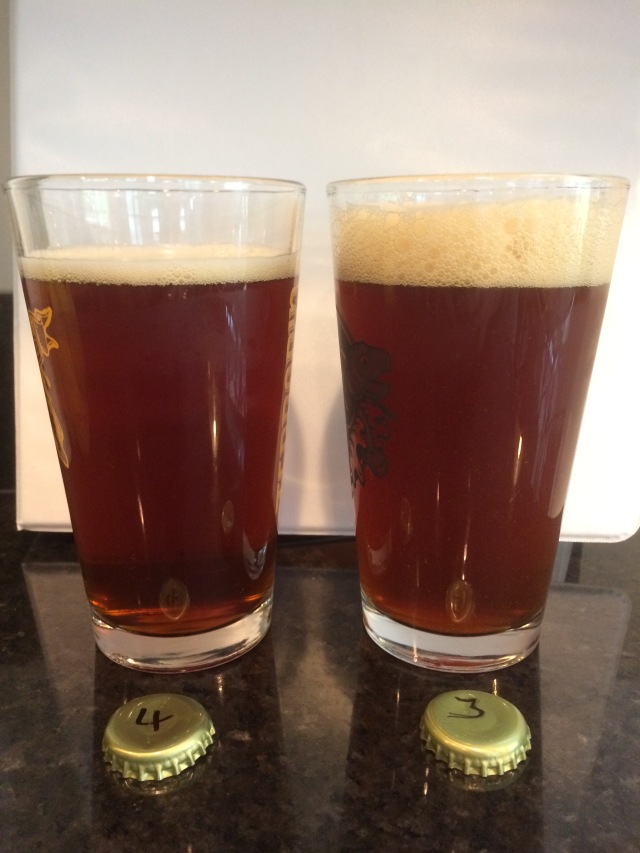This post is one in a series of making small adjustments to a single recipe in order to improve it, learn more about the impact each ingredient has on the finished product, and the art of recipe creation. The rest of the comparison tastings in this series can be found here.
After the last debacle with my efforts of comparing the different versions of this recipe side by side, I was a little leery when I poured two more pints. After all, Iteration 3 had been subject to the same methods and stored in the same conditions as the now-cidery Iterations 1 and 2. Although I feel (unfortunately) confident that Iteration 3 will go the way of 1 and 2, I was relieved to find that it had not yet had the time for oxygen to take its toll.
Recap
The differences between versions 3 and 4 of this recipe were solely in regards to the malt:
- Iteration 3 had 0.25 lbs. more malt total than Iteration 4.
- The base malt differences looked like this:
- Iteration 3 had 10.25 lbs. 2-row
- Iteration 4 had 9 lbs. 2-row and 1 lb. Dark Munich
- Iteration 4 had 0.5 lbs. more Crystal 120 than Iteration 3.
- Iteration 3 was 0.8% higher in alcohol than Iteration 4 due to differences a 4-point difference in OG (1.056 and 1.052, respectively) and a 2-point difference in FG (1.008 and 1.010, respectively).
Appearance
Both beers were red in appearance, but Iteration 4 was more of a copper/amber hue than the deep red of Iteration 3. Iteration 4 was also notably brighter.
The difference in head was a striking one. Iteration 3 had an impressive head with excellent retention, while Iteration 4’s head was lackluster at best and dissipated quickly.

Aroma
The aroma of Iteration 3 was one of citrus, floral, and cherry. Overall, I was pleased with the hop presence in a beer now two months old. The cherry, however, was more of a red cherry flavor than the black cherry flavor I am looking for.
Iteration 4 had the same familiar citrus and floral aroma that I’ve become accustomed to with this hop profile, but it also had a hint of plum.
Flavor
Iteration 3 hit my tongue with a blast of raisin. I did get other flavors in addition to the raisin, but I want to preface them with the fact that the raisin was very prominent and truly overshadowed the rest of the flavors. That said, I did also taste a floral note, and the end was one of citrus with a lingering bitterness.
Iteration 4 had a big citrus flavor that came through prominently in the way that I would hope from a red IPA. The hops also yielded some floral notes. The malt character was rich and bready. The richness was quite nice, but perhaps a bit distracting from the plum note that I would like to be more prominent.
Final Thoughts
Overall, Iteration 4 is the better beer (which continues to give me hope that I’m improving as I continue adjusting this recipe). It has more of the flavors I want coming through with less malt covering up the hops. However, the breadiness could stand to be toned down, hopefully allowing the dark fruit character to shine through.
